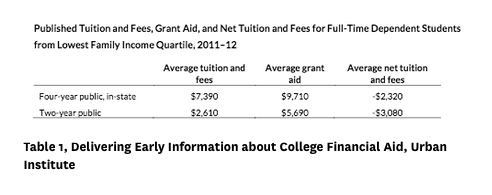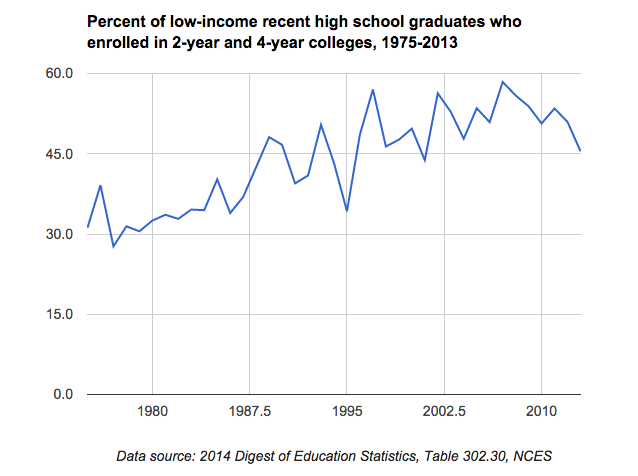Low-income students can go to college for free, but most don’t attend
Not surprisingly, the rising cost of college is a big deterrent for students from low-income families to attend college, according to a new report from Urban Institute.
Many low-income students don’t have the same access to information about college and financial aid programs from school counselors as higher-income students do, so a large portion of them decide early on that college just isn’t for them–in large part due to its high cost.
And due to this lack of information, many don’t realize how affordable college can actually be, especially for families making under $30,000 per year.
Financial aid covers low-income students’ college costs
According to the study, as reported by The Hechinger Report, full-time students from the lowest family-income quartile (family incomes under $30,000) who were enrolled in public two-year or four-year colleges in their own state received enough grant aid, on average, to cover their tuition and fees during the 2011-12 school year.
After grants (free money that doesn’t have to be paid back), the average low-income public college student actually received more money than the cost of college–which could be put toward books and living expenses.
That means they went to college for free, as you can see the graphic below.
Even students from families making up to $40,000 were able to go to college for nearly nothing.
In most cases, these students received enough grant aid to cover tuition and fees at many public institutions. And nearly half of students from families making up to $50,000 were able to do the same.
College enrollment declining for low-income students
Despite the relative affordability of college for low-income students, most of them don’t go to college.
Just 46 percent of low-income students (from the bottom 20 percent of family incomes) who recently graduated from high school were enrolled in college in 2013, according to the most recent data from the National Center for Education Statistics.
And that percentage is on the decline. In every previous year from 2005 to 2012, more than half of low-income high school graduates were enrolled in college.
To give you some perspective, 64 percent of recent high school graduates from middle income families and 79 percent from high income families were enrolled in college in 2013.
Families need financial aid information early
So what can be done to make low-income students more aware of the affordability of college?
The report advises that making families aware of financial aid and the possibility of free college before junior or senior year of high school–even as early as middle school.
If more low-income families understood their likely financial aid packages, the study argues, then more families would push their children to take the demanding courses in high school that would prepare them for college–and succeed in them.
While working might seem like an attractive option for low-income students who want to make money right away, the numbers still prove that going to college pays off–and forgoing a bachelor’s degree actually costs students $830,000 over the course of their lifetimes.
Making college affordable for all families
Low-income or not, it’s important for families to remember that a college’s published price isn’t set in stone. Financial aid and scholarships can help make college more affordable–or even free.
And by starting early, families can prepare to help their students get the most financial aid possible and make college more affordable.
We help students and families from all economic backgrounds figure out the best way to pay for college and maximize their financial aid packages. If you’d like to learn how we can help you, give Rick and Andy a call at 1-888-234-3907 or contact us using this form and we’ll get back to you right away.
affording college, applying to college, financial aid, financial aid counseling, grants, net price, scholarships


